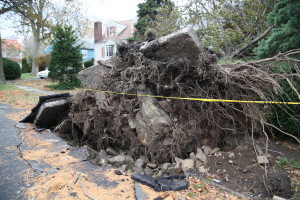Insurance industry in flux after Sandy
Insurers have paid $18.7 billion for hurricane-related damages since Sandy, making it the third costliest storm in U.S. insurance history, according to a new insurance industry analysis. Katrina and 1992”™s Andrew saw private insurers pay out more, with $48.7 billion and $25.6 billion, respectively.
The cost of the storm and the likelihood that other extreme, high-loss weather events could be a low-pressure system away mean not only changes in premiums and policies for coastal homes and businesses but a new approach from the industry as it dishes out lessons learned and braces for the next “big one.”
The average commercial claim for Sandy-related damages was for more than $44,500, according to a report from Allianz Global Corporate & Specialty Americas, an international corporate insurer based in New York City. And though businesses accounted for half of the privately-insured losses from the storm, insurers say that many businesses are no better prepared today, one year after the storm, than they were before it made landfall.

Eight of the 10 costliest storms in insurance history were in the last decade, the report said. FEMA flood maps were updated this year, with an estimated 35,000 homes in coastal areas along Westchester and New York now added to the high-risk flood plain area, according to the New York Daily News.
Tom Varney, regional manager for Allianz Risk Consulting in the Americas, said in a written statement that businesses needed to prepare for a “new normal” of extreme weather, mitigate damages and be prepared to get a business back up and running as quickly as possible following an extreme event. Adapting may not be easy.
“For many companies it takes time ”“ in some cases years ”“ to appropriate funding and actually make the much-needed changes,” Varney said. Allianz recommends that businesses prepare by developing a written emergency preparedness plan and a contingency plan that outlines how a company can become functional again after a loss. Other recommendations are knowing what a business should be prepared for in terms of high-likelihood types of damage ”“ be it damage caused by wind or floods ”“ and then understand the insurance coverage in effect to determine if additional insurance needs to be purchased.
Business interruption claims were rampant in Sandy”™s aftermath, with many businesses contending with power outages. The Allianz report recommended that businesses understand their policy limits of that coverage and to decide whether to add an extended period of indemnity clause. To limit the impact of interruption losses, insurers recommend that businesses install generators that can operate critical equipment in buildings or even act as a temporary alternative to the main power lines in the case of extended outages.
For homeowners, insurers offer similar advice in terms of buying generators for their homes, storing vital equipment and valuables in higher parts of the house when possible, maintaining sump pumps and also dealing with arborists to identify diseased or weak trees likely to topple during storms. Homeowners with means may also learn the lesson that the new normal means a broader insurance coverage: a homeowners policy, flood insurance and even excess insurance. It could also mean foregoing standard insurance for a more high-end option.
One year after Sandy made landfall, Privilege Underwriters Reciprocal Exchange, or PURE is seeing an increased interest into their specialty insurance products. PURE is a policyholder-owned insurer that caters to high-net-worth individuals and families.
Specialist insurance like PURE has some significant differences from standard insurance and those differences became accentuated during the storm. Standard insurance might cover damage from a tree that falls on a home, but wouldn”™t cover the cost of the tree falling in the yard the way certain PURE coverage might. When a car is totaled, specialty insurers often have an “agreed value” written into the contract, which means no surprises and often a quicker settlement.
The increased interest in specialty insurance is not just a matter of what is offered in a policy but how a claim is handled, according to Gary Stephen, senior vice president of claims and risk management with PURE. “It may be as much driven by the service differential as the coverage differential,” he said.
Prior to the storm, PURE made 500 outbound calls to its members along the New Jersey shore, Long Island and elsewhere asking if homeowners needed help boarding windows or securing their properties. The company made an app available to track the storm, access policy information and file claims. Forty-five percent of the membership used the app.
It brought in a staff of appraisers days before the storm, ran several dry runs and tried to plan for the type of losses they”™d be reviewing. The appraisers came with an average experience level of 19 years, Stephen said, which curbed a problem for many homeowners with standard insurers ”“ emergency appraisers underestimating what the cost of repairs would be. “When you”™re faced with that type of claim volume, you want to get it right the first time,” he said.
After the storm hit, the company overlayed a map of its insured homes with a map of the flood surge. PURE sent damage appraisers to homes within the surge area that hadn”™t filed claims in anticipation of damages there. The company also hired its own arborists for its customers.
Overall damage from Sandy are estimated at $70 billion, which makes it the second costliest storm in history after Katrina, which caused more than $100 billion worth of damage. Insured losses from Sandy total approximately $28.5 billion, with private insurance companies accounting for about 73 percent of that total, the Allianz report said. Businesses made up 48 percent of the privately insured loss from Sandy. Over 1.5 million claims were filed to private companies and 127,000 to the National Insurance Program.